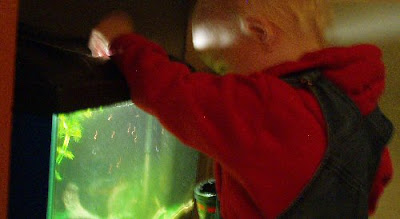 “What makes human action distinctive is the capacity of people not only to understand the world symbolically but also to understand themselves and others as symbolic and symbol-using beings” (Rock 2001). Let me explain this with a short story from the life of my two years old friend.
“What makes human action distinctive is the capacity of people not only to understand the world symbolically but also to understand themselves and others as symbolic and symbol-using beings” (Rock 2001). Let me explain this with a short story from the life of my two years old friend. He and I were watching fishes in an aquarium at my home. The boy turned to me and said a word. I understood that he addressed me with intentions to share something … may be he asked me something (he had an “asking expression” on his face), but I didn’t understand the word he had pronounced. The next second, he grabbed the plastic box with fish food and repeated the word “mise” (he was speaking Norwegian), but this time he pointed at the box with his tiny forefinger and looked strait into my eyes with his face close to mine. I guessed that he wanted to say “spise” (which means “eat”) and that his question was: “Can I feed the fishes?” But first after I had answered “Yes”, and big smile occurred on his face, I was sure that I had understood his a-half-word-question!
He and I were watching fishes in an aquarium at my home. The boy turned to me and said a word. I understood that he addressed me with intentions to share something … may be he asked me something (he had an “asking expression” on his face), but I didn’t understand the word he had pronounced. The next second, he grabbed the plastic box with fish food and repeated the word “mise” (he was speaking Norwegian), but this time he pointed at the box with his tiny forefinger and looked strait into my eyes with his face close to mine. I guessed that he wanted to say “spise” (which means “eat”) and that his question was: “Can I feed the fishes?” But first after I had answered “Yes”, and big smile occurred on his face, I was sure that I had understood his a-half-word-question!So, what actually happened here? The little boy used different forms of communication: words, body language, tone of voice and facial expression. He obviously understood that he and I were “symbol-using beings”! When one symbol didn’t function alone, he supported it with another: pointing to the physical food box - which again was a kind of symbol (food box was symbolizing the action of eating). Wasn’t that creative!? His motivation to solve the communication problems seems to lay in his desire to feed the fish.
What I find the most amazing is the way he understood that I didn’t understand his word! I believe that this is an evidence of his extreme ability to read facial expressions!
According to Ellen Dissanayake, humans have during evolution developed the ability to communicate through facial expressions in order to become enculturated in their social group, and survive – just imagine how helpless a fragile infant would be without care from its “pack”. Babies are born wanting specific kinds of interactions (Dissanayake 2007). And it is not the adults who teach them to respond but “rather infants teach us (…) they reward us so that we want to keep entertaining them” (Dissanayake 2007, p.788). It seems like my little friend has been doing a lot of successful teaching and entertaining – and has become an expert of body language. And now he uses this language competence in order to learn other languages.
Dissanayake, E. (2007). In the beginning: Pleistocene and infant aesthetics and 21st-century education in the arts. In L. Bresler. International Handbook of Research in Arts Education, Dordrecht, Springer
Rock, P. (2001). Symbolic Interactionism and Ethnography. In P. Atkinson. Handbook of ethnography. London, Sage: XVIII, 507 s.

Ingen kommentarer:
Legg inn en kommentar